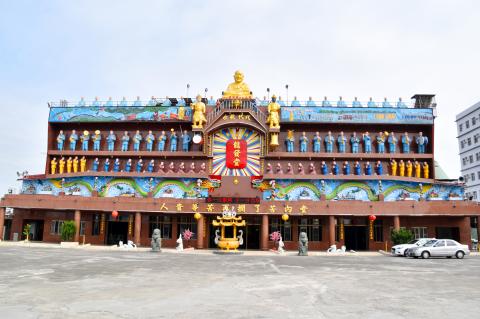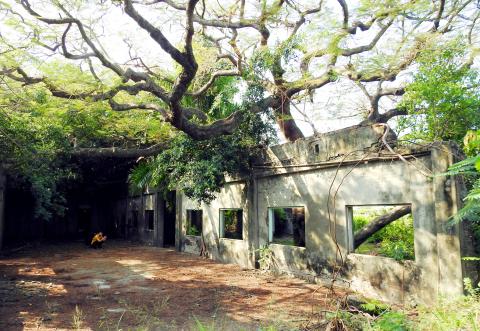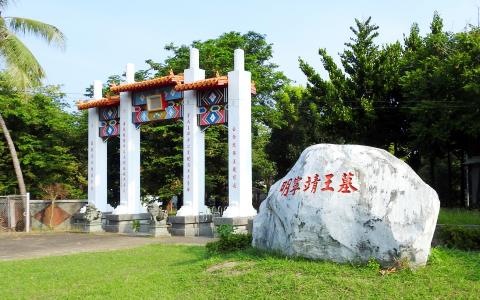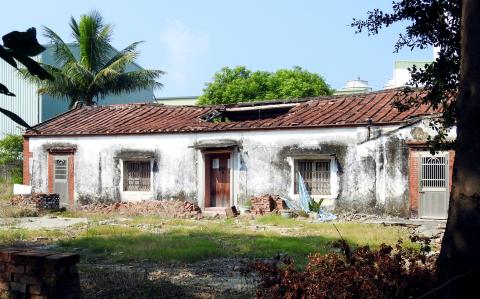Americans sometimes talk of “flyover country,” those parts of the US that coastal elites never see at ground level. If Taiwan has equivalent regions — areas seen only through the windows of a high-speed train — surely one is the 35km that separates the southern edge of Tainan City from the northern suburbs of Kaohsiung.
If you head south from the former capital on Taiwan Highway 1, Hunei District (湖內區) is the first part of Kaohsiung City you’ll encounter. During the late Qing and Japanese colonial periods, the area was known as Dahu (大湖, literally “Big Lake”) on account of the ponds and swamps that covered more than a third of the land. Most of these have been drained or filled in, but the toponym lives on in the name of the nearest railway station, Dahu TRA Station (大湖火車站).
Because it’s within commuting distance of central Tainan, the district hasn’t suffered from the kind of population outflow that depresses many parts of the southwest. Since 1991, Hunei’s population has grown about 15 percent to nearly 30,000.

Photo: Su Fu-nan, Taipei Times
THE PRINCE OF HUNEI
Locals joke that Hunei’s most famous resident doesn’t appear in the household registry because he’s been dead for 335 years. Zhu Shugui (朱術桂, 1617–1683), also known as Prince (or Lord) Ningjing (寧靖王), was the most senior of the Ming Dynasty princes who refused to recognize the succeeding Qing Dynasty.
Zhu arrived in Taiwan in 1664 and never left. When the Ming loyalist enclave in Tainan was defeated by the Qing in 1683, he committed suicide rather than surrender.

Photo: Steven Crook
During his lifetime, Zhu showed great concern for the welfare of families living in what’s now Hunei and did his best to develop the area. Realizing that the Qing conquerors might mutilate his corpse, some Hunei residents retrieved the prince’s body and organized a proper burial. To protect Zhu’s remains, they disguised his resting place and created around 100 “decoy” tombs.
Sadly for Hunei folks who are proud of their town’s Ming connection, Zhu’s remains aren’t in the Mausoleum of Lord Ningjing (明寧靖王墓). They were scattered or stolen sometime before 1937. When the grave was rediscovered that year, the casket was empty.
Apart from its impressive dimensions, not much distinguishes the tomb from many others in Taiwan. That said, the surroundings are well kept, so it’s popular with cyclists taking a break as they wait for their friends to catch up.

Photo: Steven Crook
The grave is on the north side of Highway 28, 1.5km west of the intersection between Highway 28, Highway 17, and Highway 17A (17甲). There’s no obvious English sign, nor an official parking lot, but parking a car nearby isn’t difficult.
TOMATO CANNERY RUIN
Around 2km northeast of the mausoleum stands an entirely different attraction. The Tomato Cannery (蕃茄會社) is a ruined factory at 360 Jhongshan Road Section 1, Hunei District. If you’re driving from the north, look for the 348km marker on Highway 1; the ex-cannery is on your left.

Photo: Steven Crook
For much of the year, hardly anyone visits this place and the grass grows high. But each May and June, the trees here produce such an abundance of red flowers that photographers and Instagrammers flock to the site, trampling much of the foliage flat.
This place has a beguiling appeal in any season. The ways in which banyan roots have climbed and penetrated the walls may remind you of Anping Treehouse (安平樹屋) in Tainan. No one is sure of the ex-cannery’s precise age. It was probably built before 1930. After World War II, pineapples rather than tomatoes were cut up and canned here.
If you plan to spend more than a few minutes at the ex-cannery, do wear long pants and sleeves; the mosquitos are hungry. If it’s been raining, proper shoes are a must.
Dahu TRA Station is ringed by factories, most of which manufacture processed foods. Between them are a few old and apparently unoccupied homesteads.
BIZARRE SANITORIUM
Visible if you’re traveling by train between Tainan and Kaohsiung, but hard to see if you’re getting around by other means, is the four-story facade of Longfatang (龍發堂). It’s a fabulously gaudy array of yellow, blue and brown statues, topped by a golden seated Buddha.
A quasi-religious institution of some notoriety and doubtful legality, Longfatang was founded in 1971 by a local Buddhist layman. Born Lee Chu-tai (李焜泰), but widely known by his Dharma name Kaifeng (開豐), he began to care for and instruct a friend’s son who was suffering from mental illness.
The young man’s condition apparently improved, and Lee’s willingness to take on the mentally ill was a godsend for the families of those suffering from schizophrenia and other conditions. At that time, Taiwan had very few psychiatric facilities or psychiatrists. As word spread, Longfatang grew into a community of more than 700 people.
Controversially, patients were chained together in pairs, a practice the founder regarded as entirely humane and central to the treatment regimen. Magnum photographer Chang Chien-chi (張乾琦) was allowed to take his camera inside. His portraits of chained inmates, called The Chain, were acclaimed at the 2001 Venice Biennale and later exhibited in Australia.
Most residents worked every day of the year in affiliated chicken farms, but it wasn’t allegations of exploitation that undermined Longfatang. Last year, outbreaks of amoebic dysentery and tuberculosis, coupled with an unusually high overall death rate, forced Kaohsiung City Government’s Department of Health to take action. It emerged that fewer than 20 staff, none of whom were trained in healthcare, were looking after almost 500 people. Many patients were transferred to other facilities.
In January this year, the institution announced it would no longer house mental patients. It hasn’t yet been shuttered, however. When I passed by at the beginning of this week, I spotted several people inside. I expected to see official notices warning potential visitors about the risk of infectious disease. Instead, there were bulletins complaining about the authorities’ actions. Left as it is, Longfatang is a monument of sorts to what happens when good intentions meet outright unprofessionalism.
Steven Crook has been writing about travel, culture, and business in Taiwan since 1996. Having recently co-authored A Culinary History of Taipei: Beyond Pork and Ponlai, he is now updating Taiwan: The Bradt Travel Guide.

It’s always a pleasure to see something one has long advocated slowly become reality. The late August visit of a delegation to the Philippines led by Deputy Minister of Agriculture Huang Chao-ching (黃昭欽), Chair of Chinese International Economic Cooperation Association Joseph Lyu (呂桔誠) and US-Taiwan Business Council vice president, Lotta Danielsson, was yet another example of how the two nations are drawing closer together. The security threat from the People’s Republic of China (PRC), along with their complementary economies, is finally fostering growth in ties. Interestingly, officials from both sides often refer to a shared Austronesian heritage when arguing for

The ultimate goal of the Chinese Communist Party (CCP) is the total and overwhelming domination of everything within the sphere of what it considers China and deems as theirs. All decision-making by the CCP must be understood through that lens. Any decision made is to entrench — or ideally expand that power. They are fiercely hostile to anything that weakens or compromises their control of “China.” By design, they will stop at nothing to ensure that there is no distinction between the CCP and the Chinese nation, people, culture, civilization, religion, economy, property, military or government — they are all subsidiary

Nov.10 to Nov.16 As he moved a large stone that had fallen from a truck near his field, 65-year-old Lin Yuan (林淵) felt a sudden urge. He fetched his tools and began to carve. The recently retired farmer had been feeling restless after a lifetime of hard labor in Yuchi Township (魚池), Nantou County. His first piece, Stone Fairy Maiden (石仙姑), completed in 1977, was reportedly a representation of his late wife. This version of how Lin began his late-life art career is recorded in Nantou County historian Teng Hsiang-yang’s (鄧相揚) 2009 biography of him. His expressive work eventually caught the attention

Late last month the Executive Yuan approved a proposal from the Ministry of Labor to allow the hospitality industry to recruit mid-level migrant workers. The industry, surveys said, was short 6,600 laborers. In reality, it is already heavily using illegal foreign workers — foreign wives of foreign residents who cannot work, runaways and illegally moonlighting factory workers. The proposal thus merely legalizes what already exists. The government could generate a similar legal labor supply simply by legalizing moonlighting and permitting spouses of legal residents to work legally on their current visa. But after 30 years of advocating for that reform,